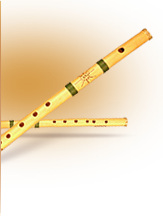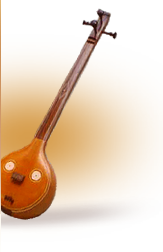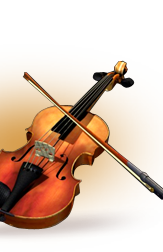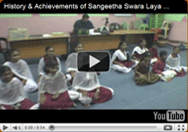HERITAGE
VEENA
Natyanjali festival opens on the auspicious occasion of the Maha Shivaratri day in the Chidambaram temple. The magnificent temple dedicated to Lord Shiva, built a thousand years ago, provides a beautiful backdrop for the event. The setting is truly divine-Chidambaram's gold-roofed temple, with pillars depicting Lord Nataraja in 108 poses or Karanas. This is an opportunity for all dancers, from all over India, to perform and pay their tribute to Lord Nataraja. The festival lasts for 5 days.
The Rudra Veena, also known as the bin (been), may be one of the oldest forms of Veena. This instrument may have evolved from a bamboo stick attached to two gourds. Such instruments are depicted on the walls of ancient temples. Only one of the toombas acts as a resonator. The latent second toomba near the top of the neck is used to assist the positioning during play. The 24 metal frets are held in place by wax formed along the sides of the neck. There are only 4 playing strings and 3 drone (thalam) strings. These Veenas do not have sympathetic strings.

FLUTE
The Flute is a wind-blowing instrument that has to be blown from the mouth. It is one of the oldest instruments of Indian classical music. It is a simple hollow cylinder derived out of bamboo or baans. There are two main varieties of flutes - the Bansuri and the Pulanguzhal. The Bansuri has six finger holes and one blowing hole and is used predominantly in Hindustani music-the music of North India. The Pulanguzhal has eight finger holes and is predominantly used in Camatic music-the music of South India. The tone of the flute varies with its length. The size of flutes varies from six inches to three feet. The bigger the flute, the deeper is its sound. Mostly the classical flute is held sideways while playing; in folk music it is held either sideways or straight like a shehnai

MIRUDHANGAM
The Mridanga or Mirudhangam etymologically means body of day. It is the most ancient of all percussion instruments and is commonly used in the South alongside the vocal and instrumental performances. The Mridanga is known by various names. In the North it is called the Pakhawaj, and in Bengal and Manipur it is known as the Khol.lt is a two-headed drum, about 60 cm in length and is made of wood in an angular barrel shape, having an outline like an elongated hexagon. The right face is slightly smaller than the left face.
The two faces are joined and held together tight by leather straps which pass in and out of the pinnals or braids on both sides. A mixture of flour and water is applied on the middle of the left side to lower the tone to the desired pitch. This gives a full, bass sound. This is removed each time after use. The center of the right side has a permanent coating of a black substance called siyahi (or soru, karanai and marundu), which is a mixture of boiled rice, manganese dust, iron filings and other substances. This layer gives characteristic tone to the Mirudhangam and facilitates tuning to a particular pitch.

TAMBURA
The Tambura (also called as the tanpura in North India) is one of the classical instruments of string variety. Its earlier avtar the tambur, which was prevalent in the 19th century, was of much smaller size. This was because its main resonator was made of a pumkin and big pumpkins were not available in India.
The length of the tambura varies from 3.5 feet to 5 feet. The hollow body of the tambura has a small neck. The bridge which is placed on the bowl in the center is made of wood or ivory. There are four metal strings attached directly to the narrow ledge fixed to the body of the tambura. Three of the strings are made of steel and the fourth and lowest one is of brass. The strings pass through holes in the ledge which is near the peg. The special drone effect comes from the flat bridge or jawari, which increases enormously the spectrum of the notes and links the vibration of the strings.The tambura is held upright while playing. Sometimes a bowl is placed on the right thigh.
The strings of the tambura are gently and continuously plucked with the fingers, one after the other. Little pieces of silk or wool are placed in certain positions between the strings and the main bridge to improve the tonal effect. Present day concerts have also started using the Electronic Tambura , which needs only plugging inand no plucking with fingers. The tonal effect is similar to that of the Traditional Tambura.

Violin
The Violin is originally a Western Instrument that has been adopted by Indian musicians. It is now an integral part of the Carnatic music. One of the special features of the Violin is its smooth sweep from one end of the string to the other. The Violin is held in a position between the right heel and chest. The left hand moves freely and the fingers of the player have a range of two and a half octaves. The Indian musicians have developed their own peculiar way of playing the violin-seated cross legged with the end of the violin's peg box resting on the right foot.

